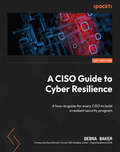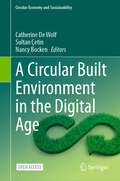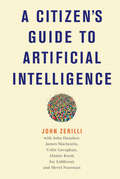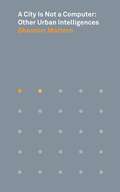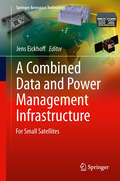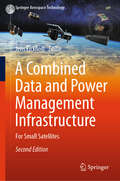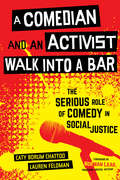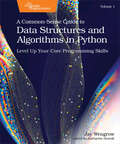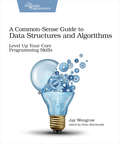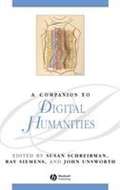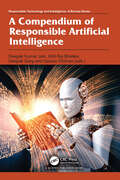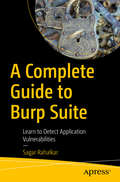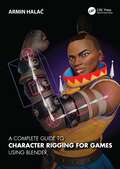- Table View
- List View
A Bug Hunter's Diary
by Tobias Klein"Give a man an exploit and you make him a hacker for a day; teach a man to exploit bugs and you make him a hacker for a lifetime." A Bug Hunter's Diary follows security expert Tobias Klein as he tracks down and exploits bugs in some of the world's most popular software.
A CISO Guide to Cyber Resilience: A how-to guide for every CISO to build a resilient security program
by Debra BakerExplore expert strategies to master cyber resilience as a CISO, ensuring your organization's security program stands strong against evolving threatsKey FeaturesUnlock expert insights into building robust cybersecurity programsBenefit from guidance tailored to CISOs and establish resilient security and compliance programsStay ahead with the latest advancements in cyber defense and risk management including AI integrationPurchase of the print or Kindle book includes a free PDF eBookBook DescriptionThis book, written by the CEO of TrustedCISO with 30+ years of experience, guides CISOs in fortifying organizational defenses and safeguarding sensitive data. Analyze a ransomware attack on a fictional company, BigCo, and learn fundamental security policies and controls. With its help, you’ll gain actionable skills and insights suitable for various expertise levels, from basic to intermediate. You’ll also explore advanced concepts such as zero-trust, managed detection and response, security baselines, data and asset classification, and the integration of AI and cybersecurity. By the end, you'll be equipped to build, manage, and improve a resilient cybersecurity program, ensuring your organization remains protected against evolving threats.What you will learnDefend against cybersecurity attacks and expedite the recovery processProtect your network from ransomware and phishingUnderstand products required to lower cyber riskEstablish and maintain vital offline backups for ransomware recoveryUnderstand the importance of regular patching and vulnerability prioritizationSet up security awareness trainingCreate and integrate security policies into organizational processesWho this book is forThis book is for new CISOs, directors of cybersecurity, directors of information security, aspiring CISOs, and individuals who want to learn how to build a resilient cybersecurity program. A basic understanding of cybersecurity concepts is required.
A Cartographic Analysis of Soviet Military City Plans (Springer Theses)
by Martin DavisThe collapse of the Soviet Union has seen the emergence of its unprecedentedly comprehensive global secret military mapping project and the commercial availability of a vast number of detailed topographic maps and city plans at several scales. This thesis provides an in-depth examination of the series of over 2,000 large-scale city plans produced in secret by the Military Topographic Directorate (Военное топографическое управление) of the General Staff between the end of the Second World War and the collapse of the USSR in 1991. After positioning the series in its historical context, the nature and content of the plans are examined in detail. A poststructuralist perspective introduces possibilities to utilise and apply the maps in new contexts, which this thesis facilitates by providing a systematic, empirical analysis of the Soviet map symbology at 1:10,000 and 1:25,000, using new translations of production manuals and a sample of the city plans. A comparative analysis with the current OpenStreetMap symbology indicates scope for Soviet mapping to be used as a valuable supplementary topographic resource in a variety of existing and future global mapping initiatives, including humanitarian crisis mapping. This leads to a conclusion that the relevance and value of Soviet military maps endure in modern applications, both as a source of data and as a means of overcoming contemporary cartographic challenges relating to symbology, design and the handling of large datasets.
A Case Study for Computer Ethics in Context: The Scandal in Academia
by Michael James Heron Pauline Helen BelfordAimed at addressing the difficulties associated with teaching often abstract elements of technical ethics, this book is an extended fictional case study into the complexities of technology and social structures in complex organizations. Within this case study, an accidental discovery reveals that the algorithms of Professor John Blackbriar are not quite what they were purported to be. Over the course of 14 newspaper articles, a nebula of professional malpractice and ethical compromise is revealed, ultimately destroying the career of a prominent, successful academic.The case study touches on many topics relevant to ethics and professional conduct in computer science, and on the social structures within which computer science functions. Themes range from the growing influence of generative AI to the difficulties in explaining complex technical processes to a general audience, also touching on the environmental consequences of blockchain technology and the disproportionate gender impacts of Coronavirus. Each new revelation in the case study unveils further layers of complexity and compromise, leading to new technical and social issues that need to be addressed.Directly aimed at making ethics in the digital age accessible through the use of real-world examples, this book appeals to computer science students at all levels of the educational system, as well as making an excellent accompaniment to lecturers and course convenors alike.
A Changing World: Proceedings of the North American Serials Interest Group, Inc. (Routledge Library Editions: Library and Information Science #1)
by Suzanne McMahon Miriam Palm Pam DunnThis book, first published in 1993, examines how the newest technological developments in information storage and processing impact print-oriented libraries. Find answers to questions on how libraries can utilize the awesome speed, remarkable storage capacity, and universal access of the new technology. Authoritative contributors provide insight, inspirations, and practical experience to the three major areas of changing technologies, changing information worldwide, and strategies and responses of libraries to these rapid changes. A Changing World looks at the future of the electronic network medium and how it will provide opportunities for accessing and using information that so far have been unimagined by the print-dominated information industry. Enlightening chapters explore the feasibility of electronic serials as a realistic replacement for print journals, the future of automated serials control systems, and the effects of information technologies on libraries as systems and librarianship as a profession. Discover timely indications for ten-year trends of the globalization of research, scholarly information, and patents. Specific international influences on information are examined including the implications of the European Community internal market for scholarly publishing and distribution, the influence of rapid changes in Eastern Europe and the former Soviet Union on scholarly publishing, and scholarly information and serials in politically turbulent Latin American countries.
A China Business Primer: Ethics, Culture, and Relationships
by Michael A. Santoro Robert ShanklinThe COVID-19 pandemic underscored longstanding fissures in China’s business relationships with the West. If the West is going to develop a relationship of mutual trust and improve business relations with China in the coming decades, it is imperative to understand how to engage with Chinese thinking on ethics in business—this book explains how. Government officials, businesspeople, and business-ethicists have trouble communicating about issues in ethics, policy, and business across the China-West divide. This book shows how to overcome the us-versus-them mindset plaguing China-West relations by presenting to Western audiences an easy-to-understand yet deeply informed primer on core ideas and perspectives in Chinese cultural and philosophical thought. The book considers original texts of Chinese philosophy and religion, and applies principles from those writings to three business-ethics topics of enduring interest to business executives, government officials, and academics, namely, the protection of intellectual property, assurance of product safety and quality in the pharmaceutical supply chain, and human rights. This book is a must-read for those who want to forge constructive relationships with their Chinese counterparts based on mutual trust and understanding. The book is specifically relevant to business executives, but it should also be of interest to policymakers, educators, and students who seek to communicate more effectively with their Chinese counterparts, in particular about difficult and contentious business, policy, and ethical issues.
A Circular Built Environment in the Digital Age (Circular Economy and Sustainability)
by Catherine De Wolf Nancy Bocken Sultan ÇetinThis open access book offers a comprehensive exploration of the digital innovations that have emerged in recent years for the circular built environment. Each chapter is meticulously crafted to ensure that both academic readers and industry practitioners can grasp the inner workings of each digital technology, understand its relevance to the circular built environment, examine real-life implementations, and appreciate the intriguing business models behind them. Our primary objective is to blend scholarly knowledge with practical inspiration by providing real-life case studies for each innovation. The authors, who possess extensive expertise in their respective fields, have contributed chapters dedicated to digital technologies within their areas of specialization. The book is organized into three distinct parts. The first part focuses on data-driven digital technologies and delves into how their capabilities can facilitate the transition to a circular built environment. Essential aspects such as building information modeling (BIM), digital twins, geographical information systems (GIS), scanning technologies, artificial intelligence (AI), data templates, and material passports are explored as vital tools for data collection, integration, and analysis in the context of circular construction. In the second part, various digital technologies for design and fabrication are introduced. Topics covered include computational design algorithms, additive and subtractive manufacturing, robotic manufacturing, and extended reality. These discussions shed light on how these technologies can be leveraged to enhance design and fabrication processes within the circular built environment. Finally, the last part of the book presents emerging digital concepts related to business and governance. It explores the role of deconstruction and reverse logistics, blockchain technology, digital building logbooks, and innovative business models as enablers of circularity in the built environment. The book concludes with a chapter dedicated to digital transformation and its potential to propel the built environment towards a regenerative future. In addition to the substantive content, the book features forewords and perspectives from esteemed experts, providing valuable economic and creative insights to complement its comprehensive approach.
A Citizen's Guide to Artificial Intelligence
by John ZerilliA concise but informative overview of AI ethics and policy.Artificial intelligence, or AI for short, has generated a staggering amount of hype in the past several years. Is it the game-changer it's been cracked up to be? If so, how is it changing the game? How is it likely to affect us as customers, tenants, aspiring home-owners, students, educators, patients, clients, prison inmates, members of ethnic and sexual minorities, voters in liberal democracies? This book offers a concise overview of moral, political, legal and economic implications of AI. It covers the basics of AI's latest permutation, machine learning, and considers issues including transparency, bias, liability, privacy, and regulation.
A City Is Not a Computer: Other Urban Intelligences (Places Books #2)
by Shannon MatternA bold reassessment of "smart cities" that reveals what is lost when we conceive of our urban spaces as computersComputational models of urbanism—smart cities that use data-driven planning and algorithmic administration—promise to deliver new urban efficiencies and conveniences. Yet these models limit our understanding of what we can know about a city. A City Is Not a Computer reveals how cities encompass myriad forms of local and indigenous intelligences and knowledge institutions, arguing that these resources are a vital supplement and corrective to increasingly prevalent algorithmic models.Shannon Mattern begins by examining the ethical and ontological implications of urban technologies and computational models, discussing how they shape and in many cases profoundly limit our engagement with cities. She looks at the methods and underlying assumptions of data-driven urbanism, and demonstrates how the "city-as-computer" metaphor, which undergirds much of today's urban policy and design, reduces place-based knowledge to information processing. Mattern then imagines how we might sustain institutions and infrastructures that constitute more diverse, open, inclusive urban forms. She shows how the public library functions as a steward of urban intelligence, and describes the scales of upkeep needed to sustain a city's many moving parts, from spinning hard drives to bridge repairs.Incorporating insights from urban studies, data science, and media and information studies, A City Is Not a Computer offers a visionary new approach to urban planning and design.
A Classroom of One: How Online Learning Is Changing our Schools and Colleges
by Gene I. MaeroffA Classroom of One is Gene Maeroff's "report from the front" on the short history and status of online learning in the United States and around the world. Maeroff is a reporter who takes you to the schools from Penn State's World Campus to the Florida Virtual School to the newly emerging online learning initiatives in Afghanistan. His journey ultimately provides a snapshot of the way in which technology is changing the minds of people with regard to the nature of higher education. He looks at the method of electronic delivery, the quality of the information being delivered and quality of interaction it engenders. He looks at the way learners are adapting to this new technology and how much responsibility is put on the student's shoulders. Finally, and maybe tellingly, he looks at the business of online learning.
A Coder Like Me
by Dr Shini SomaraEngaging illustrations and an empowering story combine to introduce young readers to the world of coding, computers and problem-solving.Curious Sam has lots of questions. What is an algorithm? Could a robot be instructed to walk a dog? What is artificial intelligence? A day spent with Auntie Jo turns into a fascinating lesson in coding for Sam! They discover that the world is full of clever computers, find out about the language they "speak" and the brilliant coders who have helped us to understand it. Maybe Sam can try out some awesome coding projects and become a coder too?With pages encouraging kids to try out coding for themselves and opening their minds to the fun things that can be created using computer code, this brilliant picture book written by engineer and TV presenter Dr Shini Somara unlocks a love of coding and computing and celebrates women in STEM.
A Collection of AI Innovations by Chinese Teenagers: Discovering Youthful Ingenuity (Smart Computing and Intelligence)
by Yanyan Li Ronghuai Huang Jinbao Zhang Dejian LiuThis book presents 10 artificial intelligence (AI) innovation projects by Chinese teenagers, including innovations on intelligent medical care, environmental protection, education, transportation, among others. It delves into the technical details of these innovations, providing readers with a comprehensive understanding of the concepts and technologies involved in each case. The book also discusses the challenges faced by young innovators and their approaches to overcome them, and serves as a valuable resource for readers interested in the practical applications of AI.
A Combined Data and Power Management Infrastructure: For Small Satellites (Springer Aerospace Technology)
by Jens EickhoffThis book describes the development and design of a unique combined data and power management infrastructure The use in small satellites gives some particular requirements to the systems like potential hardware failure robustness and handling of different types of external analog and digital interfaces. These requirements lead to a functional merge between On Board Computer and the satellite's Power Control and Distribution Unit, which results in a very innovative design and even a patent affiliation. This book provides system engineers and university students with the technical knowledge as mix between technical brochure and a user guide.
A Combined Data and Power Management Infrastructure: For Small Satellites (Springer Aerospace Technology)
by Jens EickhoffThis book describes the development and design of a unique combined data and power management infrastructure for small satellites. This new edition became necessary because in the frame of the system's impressive evolution from an academic prototype to one of today's most advanced core avionics, many elements were upgraded to their next technology generation and diverse new components complement the upgraded design. All elements are presented in updated respectively new chapters. This modular infrastructure was selected by the Swiss start-up ClearSpace SA for ESA's first mission ClearSpace-1 to remove space debris. Furthermore it is the baseline for the Thai national satellite development program and is used by an increasing number of universities worldwide for research studies.
A Comedian and an Activist Walk into a Bar: The Serious Role of Comedy in Social Justice (Communication for Social Justice Activism #1)
by Lauren Feldman Caty Borum ChattooComedy is a powerful contemporary source of influence and information. In the still-evolving digital era, the opportunity to consume and share comedy has never been as available. And yet, despite its vast cultural imprint, comedy is a little-understood vehicle for serious public engagement in urgent social justice issues – even though humor offers frames of hope and optimism that can encourage participation in social problems. Moreover, in the midst of a merger of entertainment and news in the contemporary information ecology, and a decline in perceptions of trust in government and traditional media institutions, comedy may be a unique force for change in pressing social justice challenges. Comedians who say something serious about the world while they make us laugh are capable of mobilizing the masses, focusing a critical lens on injustices, and injecting hope and optimism into seemingly hopeless problems. By combining communication and social justice frameworks with contemporary comedy examples, authors Caty Borum Chattoo and Lauren Feldman show us how comedy can help to serve as a vehicle of change. Through rich case studies, audience research, and interviews with comedians and social justice leaders and strategists, A Comedian and an Activist Walk Into a Bar: The Serious Role of Comedy in Social Justice explains how comedy – both in the entertainment marketplace and as cultural strategy – can engage audiences with issues such as global poverty, climate change, immigration, and sexual assault, and how activists work with comedy to reach and empower publics in the networked, participatory digital media age.
A Common-Sense Guide to Data Structures and Algorithms in JavaScript, Volume 1: Level Up Your Core Programming Skills
by Jay WengrowIf you thought data structures and algorithms were all just theory, you're missing out on what they can do for your JavaScript code. Learn to use Big O notation to make your code run faster by orders of magnitude. Choose from data structures such as hash tables, trees, and graphs to increase your code's efficiency exponentially. With simple language and clear diagrams, this book makes this complex topic accessible, no matter your background. Every chapter features practice exercises to give you the hands-on information you need to master data structures and algorithms for your day-to-day work. Algorithms and data structures are much more than abstract concepts. Mastering them enables you to write code that runs faster and more efficiently, which is particularly important for today's web and mobile apps. Take a practical approach to data structures and algorithms, with techniques and real-world scenarios that you can use in your daily production code. The JavaScript edition uses JavaScript exclusively for all code examples, exercises, and solutions. Use Big O notation to measure and articulate the efficiency of your code, and modify your algorithm to make it faster. Find out how your choice of arrays, linked lists, and hash tables can dramatically affect the code you write. Use recursion to solve tricky problems and create algorithms that run exponentially faster than the alternatives. Dig into advanced data structures such as binary trees and graphs to help scale specialized applications such as social networks and mapping software. You'll even encounter a single keyword that can give your code a turbo boost. Practice your new skills with exercises in every chapter, along with detailed solutions. Use these techniques today to make your JavaScript code faster and more scalable. What You Need: Certain code examples take advantage of recently introduced JavaScript features. Therefore, it's important to use a JavaScript environment that supports ECMAScript 6+ or a newer version.
A Common-Sense Guide to Data Structures and Algorithms in Python, Volume 1: Level Up Your Core Programming Skills
by Jay Wengrowp>If you thought data structures and algorithms were all just theory, you're missing out on what they can do for your Python code. Learn to use Big O notation to make your code run faster by orders of magnitude. Choose from data structures such as hash tables, trees, and graphs to increase your code's efficiency exponentially. With simple language and clear diagrams, this book makes this complex topic accessible, no matter your background. Every chapter features practice exercises to give you the hands-on information you need to master data structures and algorithms for your day-to-day work.Algorithms and data structures are much more than abstract concepts. Mastering them enables you to write code that runs faster and more efficiently, which is particularly important for today's web and mobile apps. Take a practical approach to data structures and algorithms, with techniques and real-world scenarios that you can use in your daily production code. The Python edition uses Python exclusively for all code examples, exercise, and solutions.Use Big O notation to measure and articulate the efficiency of your code, and modify your algorithm to make it faster. Find out how your choice of arrays, linked lists, and hash tables can dramatically affect the code you write. Use recursion to solve tricky problems and create algorithms that run exponentially faster than the alternatives. Dig into advanced data structures such as binary trees and graphs to help scale specialized applications such as social networks and mapping software. You'll even encounter a single keyword that can give your code a turbo boost. Practice your new skills with exercises in every chapter, along with detailed solutions.Use these techniques today to make your Python code faster and more scalable.
A Common-Sense Guide to Data Structures and Algorithms, Second Edition: Level Up Your Core Programming Skills
by Jay WengrowAlgorithms and data structures are much more than abstract concepts. Mastering them enables you to write code that runs faster and more efficiently, which is particularly important for today’s web and mobile apps. Take a practical approach to data structures and algorithms, with techniques and real-world scenarios that you can use in your daily production code, with examples in JavaScript, Python, and Ruby. This new and revised second edition features new chapters on recursion, dynamic programming, and using Big O in your daily work. Use Big O notation to measure and articulate the efficiency of your code, and modify your algorithm to make it faster. Find out how your choice of arrays, linked lists, and hash tables can dramatically affect the code you write. Use recursion to solve tricky problems and create algorithms that run exponentially faster than the alternatives. Dig into advanced data structures such as binary trees and graphs to help scale specialized applications such as social networks and mapping software. You’ll even encounter a single keyword that can give your code a turbo boost. Practice your new skills with exercises in every chapter, along with detailed solutions. Use these techniques today to make your code faster and more scalable.
A Common-Sense Guide to Data Structures and Algorithms: Level Up Your Core Programming Skills
by Jay Wengrow"Algorithms and data structures are much more than abstract concepts. Mastering them enables you to write code that runs faster and more efficiently, which is particularly important for today’s web and mobile apps. This book takes a practical approach to data structures and algorithms, with techniques and real-world scenarios that you can use in your daily production code. Graphics and examples make these computer science concepts understandable and relevant. You can use these techniques with any language; examples in the book are in JavaScript, Python, and Ruby.Use Big O notation, the primary tool for evaluating algorithms, to measure and articulate the efficiency of your code, and modify your algorithm to make it faster. Find out how your choice of arrays, linked lists, and hash tables can dramatically affect the code you write. Use recursion to solve tricky problems and create algorithms that run exponentially faster than the alternatives. Dig into advanced data structures such as binary trees and graphs to help scale specialized applications such as social networks and mapping software. You’ll even encounter a single keyword that can give your code a turbo boost. Jay Wengrow brings to this book the key teaching practices he developed as a web development bootcamp founder and educator.Use these techniques today to make your code faster and more scalable."
A Companion to Digital Art
by Christiane PaulReflecting the dynamic creativity of its subject, this definitive guide spans the evolution, aesthetics, and practice of today s digital art, combining fresh, emerging perspectives with the nuanced insights of leading theorists. Showcases the critical and theoretical approaches in this fast-moving discipline Explores the history and evolution of digital art; its aesthetics and politics; as well as its often turbulent relationships with established institutions Provides a platform for the most influential voices shaping the current discourse surrounding digital art, combining fresh, emerging perspectives with the nuanced insights of leading theorists Tackles digital art s primary practical challenges how to present, document, and preserve pieces that could be erased forever by rapidly accelerating technological obsolescence Up-to-date, forward-looking, and critically reflective, this authoritative new collection is informed throughout by a deep appreciation of the technical intricacies of digital art
A Companion to Digital Humanities
by Susan Schreibman Ray Siemens John UnsworthThis Companion offers overview of the emerging field of humanities computing. Major sections focus on the experience of particular disciplines in applying computational methods to research problems; the basic principles of humanities computing and archiving.
A Compendium of Responsible Artificial Intelligence (Responsible Technology and Intelligence)
by Deepak Garg Deepak Kumar Jain Gaurav Dhiman Kirti Raj BhateleTaking a broad, multidisciplinary approach to the ethical, legal, and practical dimensions of developing AI, the book puts key issues such as bias, transparency, accountability, and privacy at center stage. From computer science through law and ethics into policy, it lays down the roadmap on which developers, data scientists, and policymakers could bring AI technologies properly attuned to societal values. This book can be read as a resource for those who want to be able to guide the development and deployment of responsibly controlled AI systems.
A Complete Guide to Burp Suite: Learn to Detect Application Vulnerabilities
by Sagar RahalkarUse this comprehensive guide to learn the practical aspects of Burp Suite—from the basics to more advanced topics. The book goes beyond the standard OWASP Top 10 and also covers security testing of APIs and mobile apps. Burp Suite is a simple, yet powerful, tool used for application security testing. It is widely used for manual application security testing of web applications plus APIs and mobile apps. The book starts with the basics and shows you how to set up a testing environment. It covers basic building blocks and takes you on an in-depth tour of its various components such as intruder, repeater, decoder, comparer, and sequencer. It also takes you through other useful features such as infiltrator, collaborator, scanner, and extender. And it teaches you how to use Burp Suite for API and mobile app security testing.What You Will Learn Understand various components of Burp Suite Configure the tool for the most efficient use Exploit real-world web vulnerabilities using Burp Suite Extend the tool with useful add-onsWho This Book Is ForThose with a keen interest in web application security testing, API security testing, mobile application security testing, and bug bounty hunting; and quality analysis and development team members who are part of the secure Software Development Lifecycle (SDLC) and want to quickly determine application vulnerabilities using Burp Suite
A Complete Guide to Character Rigging for Games Using Blender
by Armin HalačThis book is a comprehensive guide to using Blender to create character rigs for games, breaking down the technicalities of rigging tools and techniques into easily digestible chunks. It provides all the tools needed to go from a static character model to an animation-ready, high quality, and fast performing game rig. Written to be accessible and easy to follow, the book covers character rigging theory that is supported by industry standard examples of how to apply that theory to character rigs for video games. It demonstrates the reasoning behind rigging decisions followed by instructions and examples on how to apply that knowledge to rig creation. It includes chapters that focus on the character deformation techniques that raise the visual quality of the model and subsequently of the animation and game it will be used in. This book will be vital reading to those studying games animation as well as early-career rigging artists, character animators, modeling artists, technical animators, and technical artists.
A Complete Guide to DevOps with AWS: Deploy, Build, and Scale Services with AWS Tools and Techniques
by Osama MustafaGain a thorough understanding of DevOps concepts and learn to deploy AWS DevOps services in an organization. This book covers AWS DevOps deployment and building applications and services for enhanced performance. A Complete Guide to DevOps with AWS will show you how to use AWS DevOps to launch and scale services using AWS tools. It demonstrates how to handle infrastructure as code such as AWS CodeCommit, AWS CodeBuild, and AWS CodeArtifact, and how to adapt your software with familiar tools such as terraform and cloud formation. This practice also helps in the continuous integration and deployment of pipelines such as AWS CodeDeploy and AWS CodePipeline with different deployment strategies. You will also learn how to find bugs quicker, enhance software quality, reduce your time to market, and how to build, test, and prepare for a release with frequent code changes. You will also see how to scale your applications to provide maximum performance for users with high traffic. The book also covers monitoring and logging applications, giving an overall picture of the ecosystem of product development. It also explains Kubernetes in depth with AWS EKS. It concludes by walking you through how to build projects with AWS DevOps tools and technologies. After completing this book, you will have gained a solid understanding of the concepts of AWS DevOps through examples, including building projects with integration of software tools. What You Will Learn Automate processes with AWS toolsUnderstand AWS Services for Continuous deployment, and how to use themUse infrastructure as code with AWS in different formatsIntegrate AWS security into DevOps Who This Book Is For DevOps professionals and cloud engineers.

